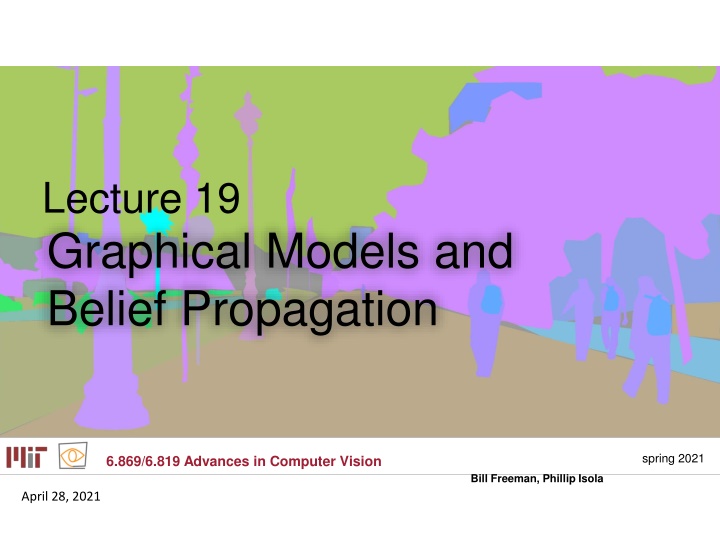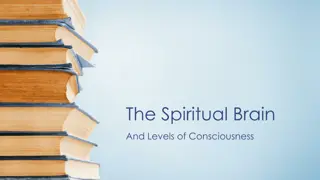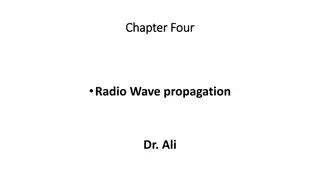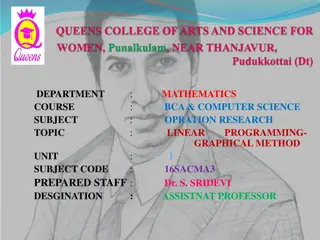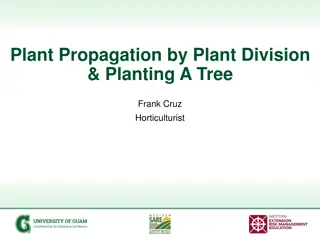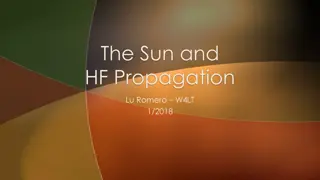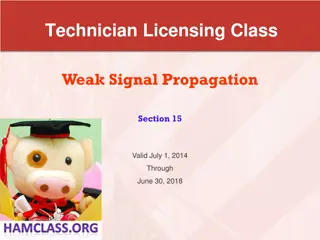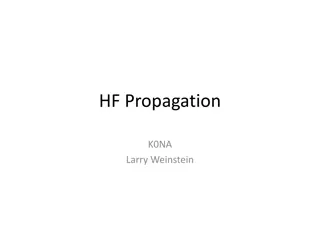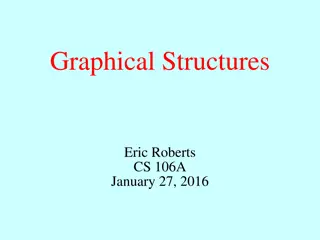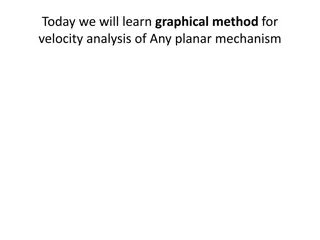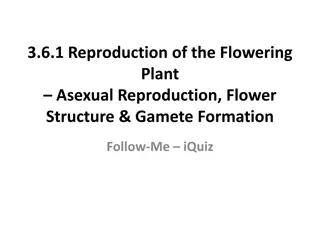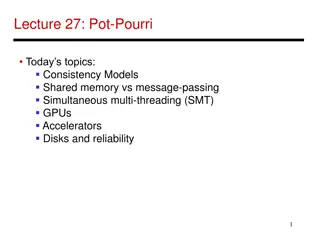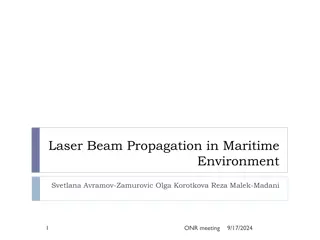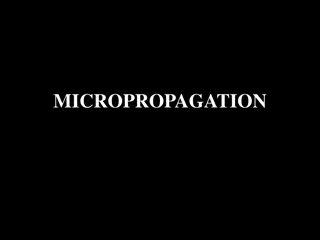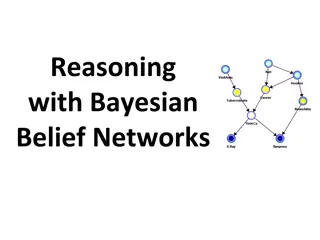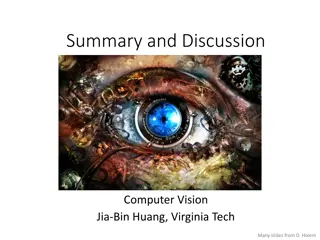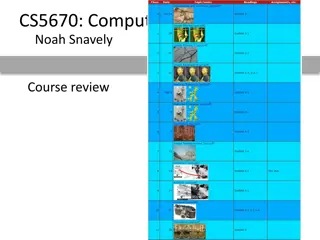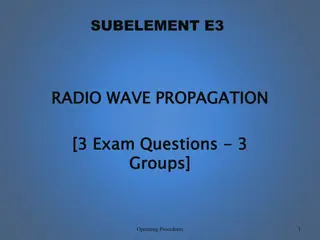Graphical Models and Belief Propagation in Computer Vision
Identical local evidence can lead to different interpretations in computer vision, highlighting the importance of propagating information effectively. Probabilistic graphical models serve as a powerful tool for this purpose, enabling the propagation of local information within an image. This lecture discusses the significance and applications of graphical models and belief propagation in the field of computer vision, emphasizing the essential role they play in processing and understanding visual data. Various research papers from CVPR 2014 are referenced to showcase the practical implications of these models in advancing computer vision technologies.
Download Presentation

Please find below an Image/Link to download the presentation.
The content on the website is provided AS IS for your information and personal use only. It may not be sold, licensed, or shared on other websites without obtaining consent from the author.If you encounter any issues during the download, it is possible that the publisher has removed the file from their server.
You are allowed to download the files provided on this website for personal or commercial use, subject to the condition that they are used lawfully. All files are the property of their respective owners.
The content on the website is provided AS IS for your information and personal use only. It may not be sold, licensed, or shared on other websites without obtaining consent from the author.
E N D
Presentation Transcript
Lecture 19 Graphical Models and Belief Propagation spring 2021 6.869/6.819 Advances in Computer Vision Bill Freeman, Phillip Isola April 28, 2021
Information must propagate over the image. Local information... ...must propagate Probabilistic graphical models are a powerful tool for propagating information within an image. And these tools are used everywhere within computer vision now.
http://www.cvpapers.com/cvpr2014.html From a random sample of 6 papers from CVPR 2014, half had figures that look like this... 7
Partial Optimality by Pruning for MAP-inference with General Graphical Models, Swoboda et al http://hci.iwr.uni-heidelberg.de/Staff/bsavchyn/papers/swoboda- GraphicalModelsPersistency-with-Supplement-cvpr2014.pdf 8
Active flattening of curved document images via two structured beams, Meng et al. file:///Users/billf/Downloads/dewarp_high.pdf 9
A Mixture of Manhattan Frames: Beyond the Manhattan World, Straub et al http://www.jstraub.de/download/straub2014mmf.pdf 10
MRF nodes as patches image patches scene patches image (xi, yi) (xi, xj) 17 scene
Super-resolution Image: low resolution image Scene: high resolution image ultimate goal... image scene 46 53
Pixel-based images are not resolution independent Pixel replication Cubic spline, Cubic spline sharpened Training-based super-resolution Polygon-based graphics images are resolution independent 47
3 approaches to perceptual sharpening amplitude (1) Sharpening; boost existing high frequencies. (2) Use multiple frames to obtain higher sampling rate in a still frame. (3) Estimate high frequencies not present in image, although implicitly defined. spatial frequency amplitude In this talk, we focus on (3), which we ll call super-resolution . spatial frequency 48
Training images, ~100,000 image/scene patch pairs Images from two Corel database categories: giraffes and urban skyline . 50 57
Do a first interpolation Zoomed low-resolution Low-resolution 51
Zoomed low-resolution Full frequency original Low-resolution 52
Representation Zoomed low-freq. Full freq. original 53
Representation Zoomed low-freq. Full freq. original True high freqs Low-band input (contrast normalized, PCA fitted) (to minimize the complexity of the relationships we have to learn, we remove the lowest frequencies from the input image, and normalize the local contrast level). 54 61
Gather ~100,000 patches ... ... high freqs. low freqs. Training data samples (magnified) 55
Nearest neighbor estimate True high freqs. Input low freqs. Estimated high freqs. ... ... high freqs. low freqs. 56 Training data samples (magnified)
Nearest neighbor estimate Input low freqs. Estimated high freqs. ... ... high freqs. low freqs. 57 Training data samples (magnified)
Example: input image patch, and closest matches from database Input patch Closest image patches from database Corresponding high-resolution patches from database 58
Scene-scene compatibility function, (xi, xj) Assume overlapped regions, d, of hi-res. patches differ by Gaussian observation noise: Uniqueness constraint, not smoothness. 60 d
y Image-scene compatibility function, (xi, yi) x Assume Gaussian noise takes you from observed image patch to synthetic sample: 61
Markov network image patches (xi, yi) scene patches (xi, xj) 62
Belief Propagation After a few iterations of belief propagation, the algorithm selects spatially consistent high resolution interpretations for each low-resolution patch of the Input input image. Iter. 0 Iter. 1 Iter. 3 63
Zooming 2 octaves We apply the super-resolution algorithm recursively, zooming up 2 powers of 2, or a factor of 4 in each dimension. 85 x 51 input 64 Cubic spline zoom to 340x204 Max. likelihood zoom to 340x204
Now we examine the effect of the prior assumptions made about images on the high resolution reconstruction. First, cubic spline interpolation. Original 50x58 (cubic spline implies thin plate prior) True 200x232 65
Original 50x58 (cubic spline implies thin plate prior) True 200x232 Cubic spline 66
Next, train the Markov network algorithm on a world of random noise images. Original 50x58 Training images True 67
The algorithm learns that, in such a world, we add random noise when zoom to a higher resolution. Original 50x58 Training images Markov network True 68
Next, train on a world of vertically oriented rectangles. Original 50x58 Training images True 69
The Markov network algorithm hallucinates those vertical rectangles that it was trained on. Original 50x58 Training images Markov network True 70
Now train on a generic collection of images. Original 50x58 Training images True 71
The algorithm makes a reasonable guess at the high resolution image, based on its training images. Original 50x58 Training images Markov network True 72
Generic training images Next, train on a generic set of training images. Using the same camera as for the test image, but a random collection of photographs. 73
Original 70x70 Cubic Spline Markov net, training: generic True 280x280 74
Kodak Imaging Science Technology Lab test. 3 test images, 640x480, to be zoomed up by 4 in each dimension. 8 judges, making 2-alternative, forced-choice comparisons. 75 82
Algorithms compared Bicubic Interpolation Mitra's Directional Filter Fuzzy Logic Filter Vector Quantization VISTA 76
Bicubic spline Altamira VISTA 77 84
Bicubic spline Altamira VISTA 78
User preference test results The observer data indicates that six of the observers ranked Freeman s algorithm as the most preferred of the five tested algorithms. However the other two observers rank Freeman s algorithm as the least preferred of all the algorithms . Freeman s algorithm produces prints which are by far the sharpest out of the five algorithms. However, this sharpness comes at a price of artifacts (spurious detail that is not present in the original scene). Apparently the two observers who did not prefer Freeman s algorithm had strong objections to the artifacts. The other observers apparently placed high priority on the high level of sharpness in the images created by Freeman s algorithm. 79
80 87
81 88
Training images 82 89
code available online http://people.csail.mit.edu/billf/project%20pages/sresCode/Markov%20Random%20Fields%20fo r%20Super-Resolution.html 85
